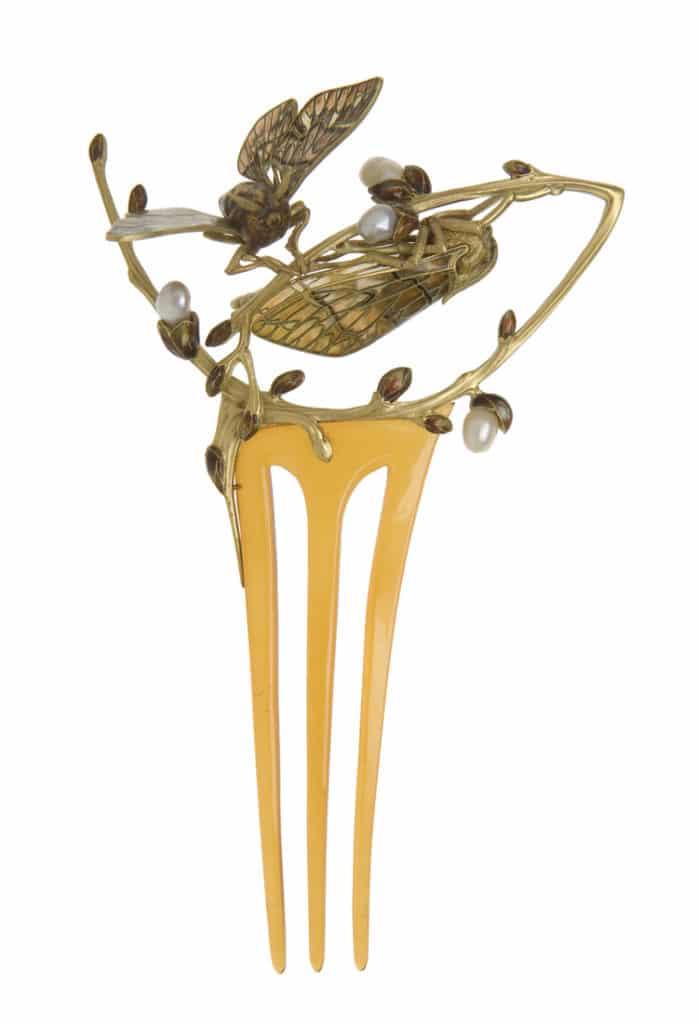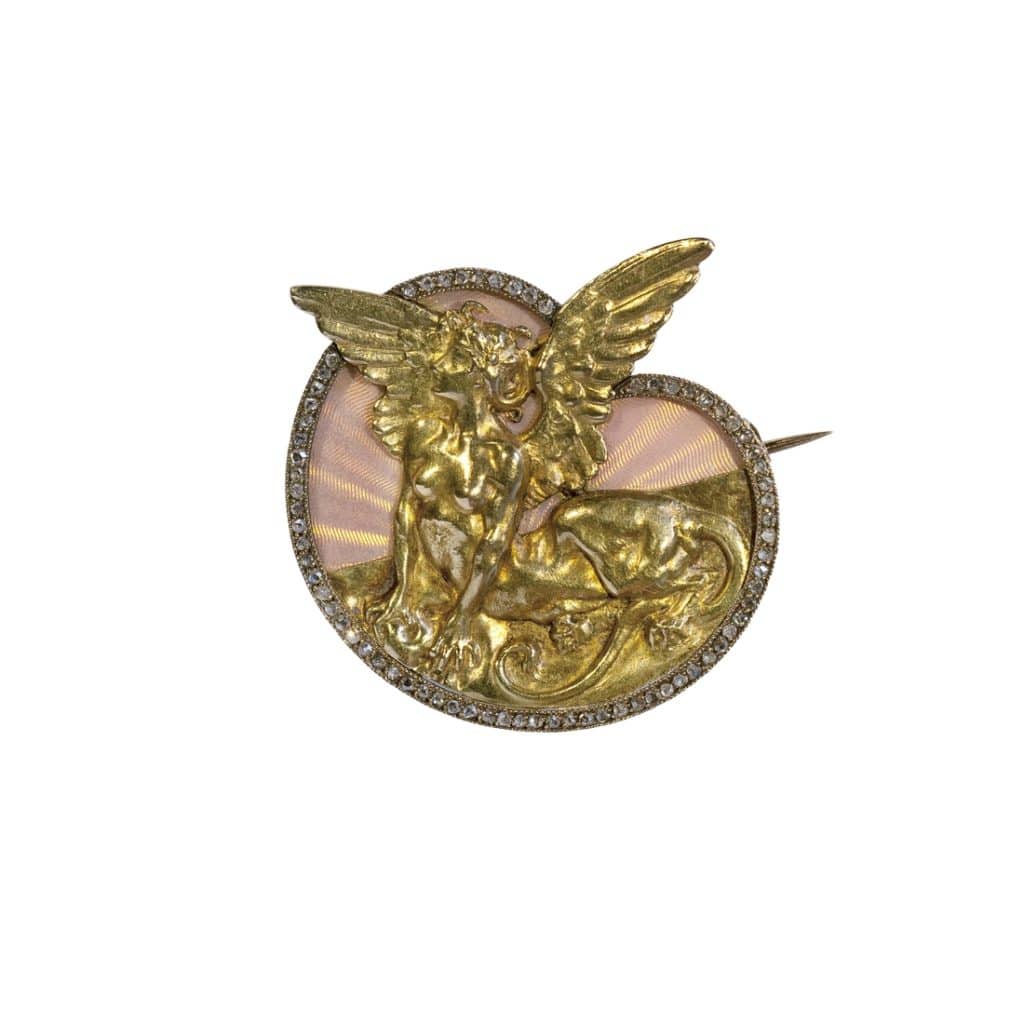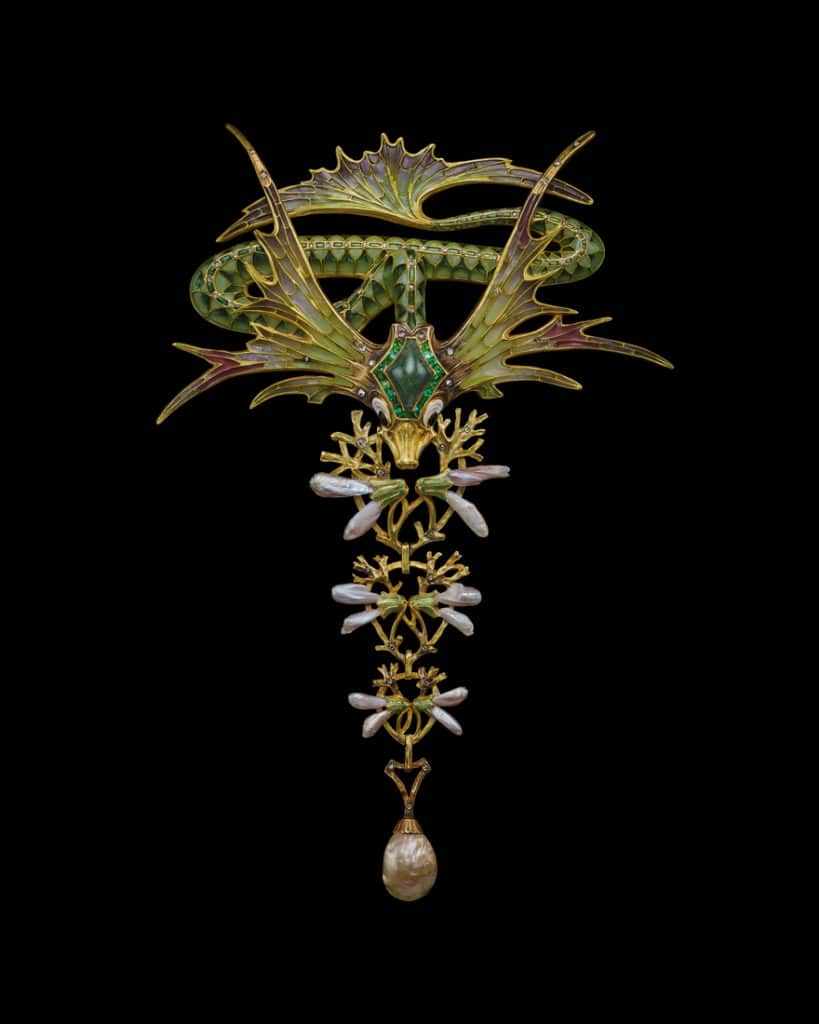From 2 June to 30 September 2023, L’École des Arts Joailliers is presenting a remarkable free exhibition on this artistic movement which is now almost universally admired. And yet this was not always the case. The École des Arts Joailliers is inviting you to discover the jewelers who created these incredible pieces of jewelry, most of them highly poetic, by bringing together around a hundred absolutely superb pieces over the next month.

Gift of Madame Gaston Chopard, 1952, inv. 37291 Paris, Musée des Arts décoratifs © Les Arts Décoratifs – Jean-Marie Del Moral
1- Art Nouveau, an innovative but fleeting movement
Although the Art Nouveau movement is almost universally acclaimed today, it took a genuine rediscovery of the movement to make people forget all the destructions of the mid-twentieth century, when the “noodle style” was no longer popular as vases and objects that many people found too heavy were put back in their attics. But since the end of the 90s, the general public has been rediscovering this movement.
This is due, or rather fortunate, to 1999 and the centenary of the École de Nancy, the spearhead of Art Nouveau in France, which brought the work of designers such as Gallé, Majorelle and Prouvé, who were committed to changing the way the decorative arts were perceived. The restoration of buildings and the various exhibitions that have taken place since then are testament to the fact that this short but fertile period is now deeply rooted in the popular imagination.

Photo Benjamin Chelly
With its roots in the Arts & Crafts movement born in England in the 1860s, Art Nouveau emerged around the 1890s with the desire to revalue the hand, the gesture and, more broadly, the “doing”. Siegfried Bing took up the expression used by Edmond Picard in 1894 in the Belgian magazine L’Art moderne to designate those who opposed historicism, and used it as the sign for his shop on rue de Provence in Paris, which opened in 1895. By appropriating every possible medium of expression, Art Nouveau became a total art form.
While the exhibition focuses on the extreme dates of the movement, 1880-1914, in an attempt to offer a broader reading of its inspirations and to identify its roots, its legacy and the causes of its demise, the period of glory of Art Nouveau in jewelry is much more limited, extending more generally from the early 1890s to 1905/1906. From the early 1910s onwards, jewelry changed, as shown by René Lalique’s remarkable steel brooch, which was sold in December 2021 at the Claude H. Sorbac Collection auction and is now owned by the Shai Bandmann & Ronald Ooi Collection and on deposit at the Musée Lalique in Wingen-sur-Moder.

Deposit Shai Bandmann & Ronald Ooi. Photo Musée Lalique © Karine Faby
2- Art Nouveau, flower women and nature sublimated
At the turn of the twentieth century, society was in a state of creative ferment. The Industrial Revolution, colonial expansion, technological progress and the (too?) rapid evolution of society all demonstrated the need to put down roots. The rediscovery of forgotten civilisations opens the way to a form of nostalgia in which the past is better than the present. With the rediscovery of history also comes the rediscovery of ancient styles, which provide powerful inspiration for the artists of the day who reinterpret them. Lalique’s Sphynx brooch (1893) is a case in point.
In the midst of this dizzying abundance, the need for immutable points of reference became apparent. Links with the Far East and the discovery of little-known cultures opened up an almost infinite range of possibilities for jewelers, who seized on these new imaginations to create new forms, experimenting endlessly, turning jewelry into a laboratory where anything was possible. Mysterious creatures, winged snakes and mermaids are all widely represented.

Scientific progress and the rise of disciplines such as botany and geology, combined with the development of the means of dissemination, aroused passion and interest in the knowledge and understanding of living things. Nature, though mysterious, has always been fertile ground for jewelers. But with Art Nouveau, it was no longer simply a matter of representing it. It was also about sublimating it and revealing its mysterious side. In an age that moves too fast, dreams are the perfect outlet.
With Lalique, women become dragonflies. Her body is sublimated and her proportions are perfect. The woman, like nature, is an untouchable and unfathomable beauty, shrouded in mystery. At the same time, two female artistic figures played on their respective images to arouse curiosity and interest, also changing the perception of women.
Loïe Fuller danced the lily, the butterfly and the orchid. Her work combining dance and light made her emblematic of a society that was enthusiastic about technical, social and scientific progress. With her luminous dances, she transforms reality and gives the performing arts a whole new perception. In another register, the actress Sarah Bernhardt became as much a myth as a muse. Her style, boundless curiosity and freedom made her a key figure in a changing era. Mucha’s Art Nouveau posters became veritable works of art, while her image, skilfully orchestrated by her attitude, her costumes and her jewelry (signed by Lalique or Fouquet), made her inaccessible.

Photo Tsuneharu Doi ё Albion Art Institute & ADAGP, Paris, 2023
3- Misunderstanding, decline and a return to order
From the early years of the twentieth century, we can see the beginnings of a return to a certain established order. In some Art Nouveau jewelry, repetitive and symmetrical motifs appeared. One example in the exhibition is a comb by Henri Dubret dating from 1902, in the collections of the Musée d’Orsay. Far from the sublimation of nature, it is here that the decorative vocation of the naturalist motif is expressed. The jewelry and motifs gradually became more rigid and fixed.
Art Nouveau was a form of artistic utopia. The movement, which wanted to put the craftsman back at the centre of the process, also wanted wider, mass distribution, thus initiating a form of industrialisation of art. In a society in search of its identity, seduced and at the same time frightened by the rise of the machine, the movement remained accessible to few people and was mainly aimed at the bourgeoisie. But this later didn’t necessarily like to see things change. In 1904, Le Figaro welcomed the fact that no changes were being made to the Place de l’Opéra “with
these contorted ramps, these humpbacked lampposts that signal the other stations of the Métropolitain with enormous frog eyes”

Chicago The Richard H. Driehaus Collection © The Richard H. Driehaus Collection, photo Michael Tropea
Art Nouveau, misunderstood and even mocked, declined. It was criticised for being too heavy and not very functional. As the First World War approached, the time for dreaming was over and reality took over. The movement that was the essence of the pieces from this period disappeared, and ornament – structured and decorative – took its place once again.
It was not until the second half of the twentieth century that Art Nouveau regained a sense of reality, with the revival of its aesthetic in the psychedelic movement, strong political decisions – André Malraux had the Guimard Metro entrances listed in 1965 – and the opening of specialist galleries such as the Tadema Gallery in London.
Since then, Art Nouveau has regained its rightful place. The sale of numerous private collections, such as the Sorbac Collection and the Beyond Boundaries auction at Christie’s, has clearly established its status as a major movement in the history of jewelry. The current exhibition, which you absolutely must visit, will, I hope, only serve to confirm the major contribution made by the artists of this period to the history of art.
See you soon!







